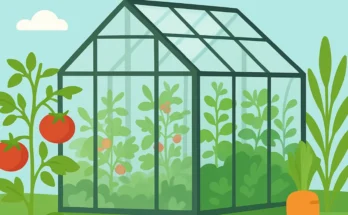Biogas introduction:
Biogas in the garden is a renewable energy source produced through the natural breakdown of organic materials such as food waste, animal manure, and plant residues in an oxygen-free environment. This process, known as anaerobic digestion, generates methane-rich gas that can be used for cooking, heating, and electricity generation. Biogas in the garden offers an eco-friendly and cost-effective alternative to fossil fuels, reducing greenhouse gas emissions while also providing a sustainable way to manage organic waste. With simple technology, even small households can set up their own biogas systems to produce clean energy and nutrient-rich fertilizer for agriculture.
Biogas in the garden
Generate Free Energy with a DIY Biogas System
Generating your own biogas is easier than you might imagine. I was amazing at how quickly it started working. Our garden has always produced a lot of organic waste, with the majority coming from mowing the lawn. Every time we cut the grass, the lawnmower collects a massive pile of clippings. Instead of discarding them, we usually toss them into the compost heap. Within just a few hours, the pile begins to heat up from the inside, changing from bright green to brown and emitting a strong odor. This natural decomposition process is the first step in biogas production—a free and sustainable energy source.
The Potential of Biogas from Organic Waste
Have you ever considered creating a small-scale biogas plant using household and garden waste? By setting up a personal biogas system, you can produce renewable energy in a cost-efficient and environmentally friendly way. Biogas technology allows you to convert organic waste into a valuable resource, reducing reliance on conventional energy sources. Best of all, the initial investment and operational expenses for a small biogas plant are minimal, making it an accessible option for many households.
Biogas is generated through anaerobic digestion, a process in which microorganisms break down organic matter in an oxygen-free environment. This produces methane-rich gas that can be used for various applications, such as cooking, heating, and even electricity generation. Additionally, the byproduct of this process, known as digestate, is a nutrient-rich fertilizer that enhances soil quality and supports plant growth.
Economic and Environmental Benefits of Biogas
Building a biogas plant at home is not only a smart financial move but also a significant step toward environmental sustainability. By producing your own biogas, you can lower your energy bills and reduce dependence on fossil fuels. Furthermore, biogas plants help minimize greenhouse gas emissions, as they prevent organic waste from decomposing in landfills, where it would otherwise release harmful methane directly into the atmosphere.
Unlike traditional energy sources that contribute to climate change, biogas follows a natural cycle. Organic waste is broken down, and the resulting gas is utilized in a controlled manner, significantly reducing environmental impact. This closed-loop system makes biogas an excellent alternative energy source for those looking to adopt a more sustainable lifestyle.
Steps to Build a Small Biogas Plant
If you are interested in setting up your own biogas system, you will be pleased to know that it is a straightforward process. With the right materials and proper design, you can easily create a functional biogas unit.
Step 1: Selecting a Suitable Location
The biogas digester should be placed in a warm, sheltered area to maintain optimal fermentation conditions. A location with adequate sunlight or insulation is ideal, as temperature plays a crucial role in the efficiency of gas production.
Step 2: Gathering Necessary Materials
To construct a basic biogas system, you will need:
- An airtight digester tank (such as a sealed plastic drum)
- A mixing chamber for combining waste and water
- An inlet pipe for feeding organic waste into the system
- An outlet pipe for extracting digestate (fertilizer byproduct)
- A gas storage container or bag to collect biogas
- Tubing and a burner for utilizing the produced gas
Step 3: Preparing and Adding Waste Materials
A variety of organic materials can be used to generate biogas, including food scraps, fruit and vegetable peels, grass clippings, and animal manure. Mixing these materials with water creates a slurry that facilitates microbial digestion within the digester.
Step 4: Maintaining Proper Conditions
For efficient gas production, it is essential to monitor the pH levels and temperature inside the digester. The ideal pH range is between 6.5 and 7.5, while the temperature should be maintained between 30-40°C (86-104°F) to support bacterial activity.
Step 5: Collecting and Utilizing Biogas
As the organic matter breaks down, methane gas is released and stored in the designated gas container. This gas can then be used for everyday activities like cooking, water heating, or even electricity generation with a small biogas-powered generator.
Common Challenges and Solutions
Although setting up a biogas plant is relatively simple, you may encounter some challenges. One common issue is an imbalance in input materials, which can slow down gas production. To ensure efficiency, add a balanced mix of nitrogen-rich (green waste) and carbon-rich (brown waste) materials.
Gas leakage is another potential problem. Regularly inspecting the seals on your digester and gas storage unit can help prevent this. If you notice reduced gas output, temperature fluctuations or an improper pH balance might be the cause—adjusting these factors can restore optimal performance.
Accessing Expert Guidance
If you are eager to start your biogas journey but need additional help, there are plenty of resources available. Online guides, video tutorials, and expert consultations can provide valuable insights into designing and optimizing your biogas system. Whether you are a beginner or looking to refine an existing setup, expert advice can enhance your experience and ensure success.
For a detailed step-by-step guide, consider investing in an e-book or enrolling in an online course. These resources offer in-depth knowledge, troubleshooting strategies, and innovative techniques to maximize biogas output from household waste.
Conclusion
Building a small biogas plant is a practical and rewarding way to harness renewable energy while reducing waste. By converting kitchen scraps and garden clippings into biogas, you can become more self-sufficient and contribute to a cleaner, greener
planet. The process is easy, cost-effective, and beneficial for both the environment and your household budget.
With minimal investment and a bit of effort, you can create a sustainable energy source right in your backyard. Start today and take a step toward energy independence and environmental responsibility!




4 Comments on “Biogas in the garden – constructions for self-su E-books”